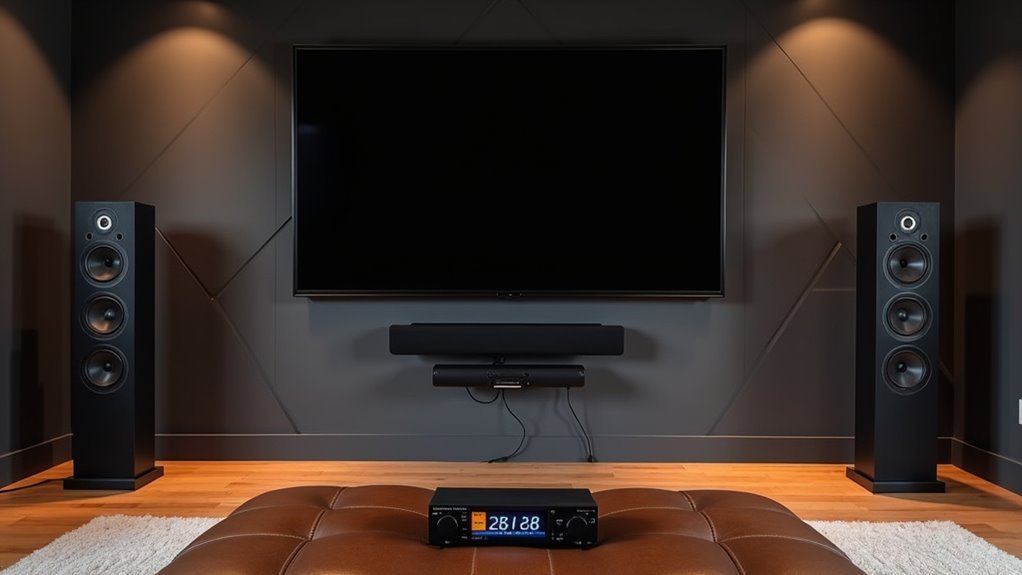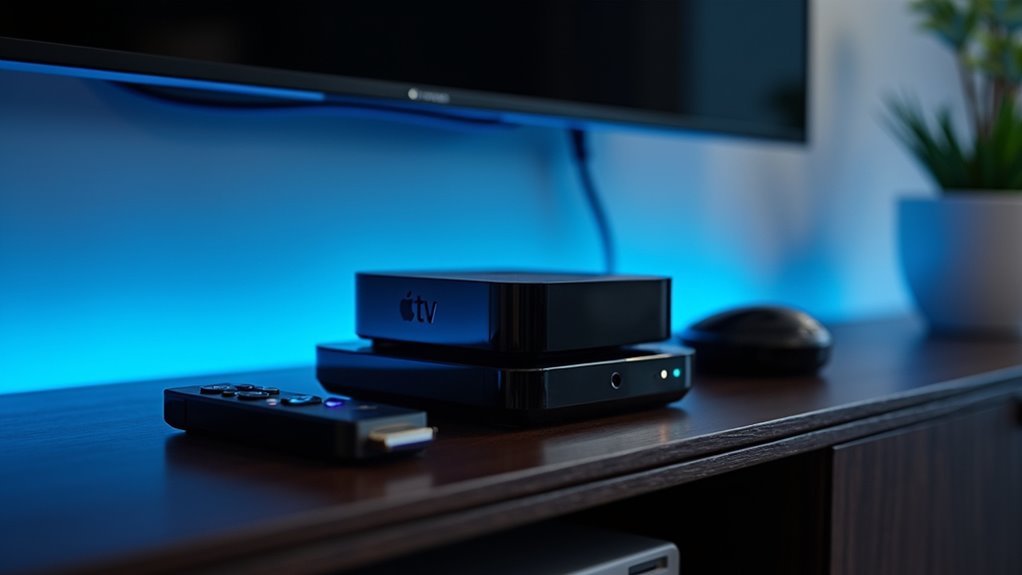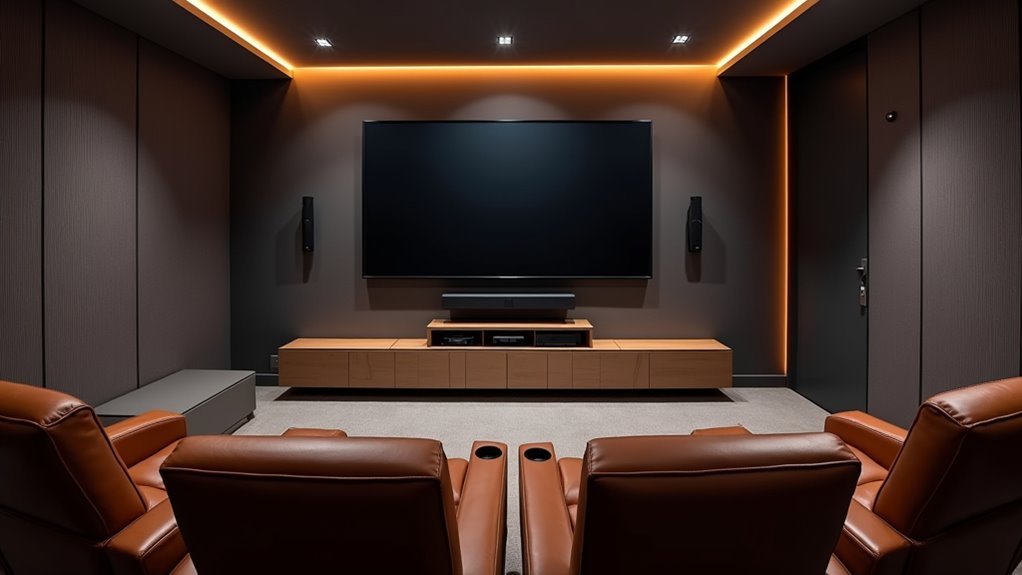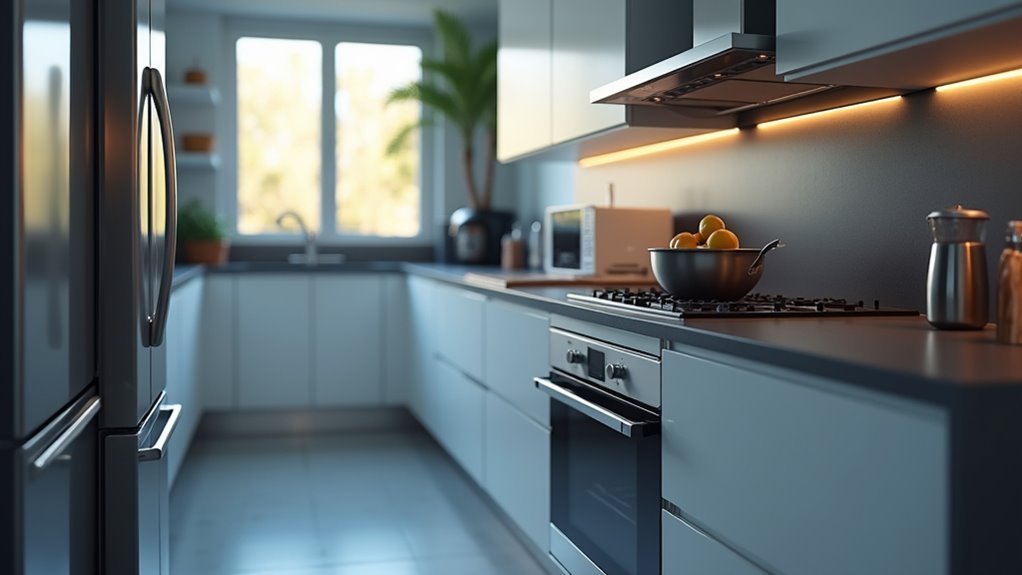You’ve invested in a home theater system, but something’s missing. The sound doesn’t quite fill the room the way you expected, and the picture quality falls short of that cinema experience you’re after. Whether you’re dealing with muddy audio, poor screen positioning, or outdated playback devices, these upgrades can transform your setup from disappointing to spectacular without breaking the bank.
Optimize Audio Equipment Placement and Calibration

Why does your expensive home theater system sound underwhelming despite its premium components? Poor audio equipment placement and calibration are often the culprits.
To optimize your surround sound, position speakers symmetrically around listening positions at 45-60 degree angles for focused sound quality. Place your center channel at ear level, away from walls to prevent resonances affecting dialogue clarity.
Calibration matters tremendously. Use a sound level meter to balance speaker levels and distances, targeting 85 dBC SPL for reference levels across all listening positions.
Experiment with subwoofer placement in corners or along boundaries to enhance bass response while minimizing room modes.
Install acoustic treatments like absorption panels at reflection points—identify these using a mirror from your main listening position to control echoes and dramatically improve clarity.
Enhance Display Quality Through Proper Setup
Perfect audio means nothing if your display delivers poor picture quality that undermines your viewing experience. Start by ensuring your TV or projector is properly calibrated, as most devices ship in store demo mode that actually diminishes display quality.
Position your screen at eye level to maximize viewing comfort and prevent neck strain.
Implement proper lighting techniques by adding bias lighting behind your display. This reduces eye strain while improving contrast levels for your home theater experience.
If you’re using a projector, invest in a dedicated projector screen rather than projecting onto blank walls—this dramatically improves image sharpness and color accuracy.
Calculate your ideal viewing distance by positioning yourself 1.5 to 2.5 times your screen size diagonal away for 4K displays.
Upgrade Media Streaming and Playback Devices

How can outdated streaming devices bottleneck your entire home theater setup? When you upgrade media streaming devices, you’ll reveal superior video and audio formats that transform your viewing experience.
A 4K Blu-ray player delivers exceptional playback quality that surpasses streaming services, while modern media streamers like Roku, Amazon Fire TV, or Apple TV offer intuitive interfaces and extensive 4K content libraries.
Choose devices supporting HDR formats for enhanced color and contrast that makes visuals more lifelike. Advanced audio formats like Dolby Atmos create an immersive sound experience when paired with compatible equipment.
However, verify your internet speed meets 25 Mbps minimum requirements for seamless 4K streaming without buffering interruptions.
Improve Room Acoustics and Lighting Control
Even the best audio and video equipment can’t overcome poor room acoustics and inadequate lighting control.
You’ll need acoustical treatment covering 15% to 20% of your room’s surfaces to manage reflective surfaces and enhance sound quality. Install bass traps in corners to absorb low frequencies and improve your immersive audio experience.
Don’t overlook soft furnishings like rugs and curtains, which naturally dampen sound reflections and improve room acoustics.
For lighting control, blackout curtains or shades eliminate external light interference, dramatically improving screen contrast and your viewing experience.
Position speakers away from walls and use rubber feet to reduce resonance.
These strategic improvements work together, transforming your space into a properly tuned environment where your equipment can perform at its full potential.
Add Smart Home Integration for Seamless Operation

While your home theater’s acoustics and lighting create the foundation for great entertainment, smart home integration takes your setup to the next level by eliminating the complexity of managing multiple devices.
Voice control through Amazon Echo or Google Home lets you adjust power, volume, and inputs with simple commands. Smart lighting solutions like Philips Hue automatically adjust brightness and color based on your content, creating immersive atmospheres.
Smart home integration transforms your entertainment space into an effortlessly controlled, atmospheric experience with just your voice.
Automation systems can synchronize your entire setup, offering one-touch settings for movie nights or gaming sessions. You’ll save energy and gain convenience by using smart plugs to remotely control AV devices.
A universal remote like Logitech Harmony consolidates multiple controls into one interface, streamlining your home theater operation for seamless entertainment experiences.
Frequently Asked Questions
How to Improve Your Home Theater System?
You’ll improve your home theater by calibrating audio-video equipment, upgrading to 4K/HDR devices, adding soundbars or subwoofers, optimizing room acoustics with soft furnishings, and regularly adjusting seating plus speaker placement.
How Can I Improve My 5.1 Surround Sound?
Position all speakers at ear level and angle them toward your listening area. Use a quality AV receiver with Dolby Digital support, calibrate regularly with an SPL meter, and experiment with subwoofer placement.
How Do I Upgrade My Home Cinema?
You’ll want to upgrade your display first, then invest in better audio equipment like a quality soundbar. Don’t forget to improve your media sources with 4K streaming devices and optimize your room’s lighting.
Is an Amplifier Worth It for Home Theater?
You’ll find an amplifier worthwhile if you’re experiencing distorted audio, want louder volumes without strain, or have high-end speakers needing more power than your receiver provides for peak performance.





Leave a Reply